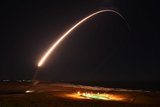Northrop Grumman achieves design milestone for US Pacific missile tracking
Northrop Grumman's RGS-A will be deployed to Guam and is on schedule to be installed by late 2025. (image: Northrop Grumman)
Northrop Grumman Corporation has recently completed a preliminary design review (PDR) of the Relay Ground Station-Asia (RGS-A) for the US Naval Information Warfare Center (NIWC) Pacific.
RGS-A will connect legacy and next-generation satellites and end users, and completion of the PDR confirms the effort is on track to renew existing missile warning systems.
The review was completed a month ahead of schedule.
Related Articles
Guam falls under temporary protection of Iron Dome
Northrop Grumman advances airborne connectivity for US Air Force
Why the US cannot overcome Russian and Chinese hypersonic weapons
Aaron Dann, VP, strategic force programmes, at Northrop Grumman said: 'The preliminary design review exceeded our customers’ expectations and is the next step in delivering much-needed new capabilities to the Pacific region.'
RGS-A supports the US Space Force's Future Operationally Resilient Ground Evolution (FORGE) system. This includes relay ground stations capable of supporting existing and new constellations with the ability to handle changes in bandwidth and availability.
Northrop Grumman was awarded a $99.6 million five-year contract by NIWC Pacific last year to design, develop, integrate, test and deliver the RGS-A.
NIWC Pacific will develop six antennas for RGS-A to enable the Space Systems Command Space-Based Infrared System (SBIRS) network which keeps legacy satellites in geosynchronous orbit. RGS-A will be deployed to Guam and is on schedule to be installed by late 2025.
More from Digital Battlespace
-
![Babcock nears first customer for Nomad AI translation tool]()
Babcock nears first customer for Nomad AI translation tool
Nomad can provide militaries with real-time intelligence, saving critical time on the battlefield.
-
![AUSA 2025: Israel’s Asio Technologies to supply hundreds of improved Taurus tactical systems]()
AUSA 2025: Israel’s Asio Technologies to supply hundreds of improved Taurus tactical systems
Taurus operates alongside the Israel Defense Forces’ Orion system which supports mission management across tens of thousands of manoeuvring forces, from squad leaders to battalion commanders.
-
![AUSA 2025: Kopin pushes micro-LED plans as China moves faster]()
AUSA 2025: Kopin pushes micro-LED plans as China moves faster
The plan for the new displays follows fresh investment in Kopin’s European facilities by Theon and an order for head-up displays in fielded aircraft, with funding from the US Department of Defense.
-
![AUSA 2025: Persistent Systems to complete its largest order by year’s end]()
AUSA 2025: Persistent Systems to complete its largest order by year’s end
Persistent Systems received its largest ever single order for its MPU5 devices and other systems earlier this month and has already delivered the 50 units to the US Army’s 4th Infantry Division.
-
![Aselsan brings in dozens of companies and systems under the Steel Dome umbrella]()
Aselsan brings in dozens of companies and systems under the Steel Dome umbrella
Turkey has joined the family of countries attempting to establish a multilayered air defence system with government approval in August 2024 for the effort landed by Aselsan. Dubbed Steel Dome, the programme joins Israel’s Iron Dome, the US Golden Dome, India’s Mission Sudarshan Chakra and South Korea’s low-altitude missile defence system.
-
![DSEI 2025: MARSS unveils new agnostic multidomain C4 system]()
DSEI 2025: MARSS unveils new agnostic multidomain C4 system
MARSS’ NiDAR system has been deployed using sensors from static platforms to provide detection and protection for static sights, such as critical infrastructure, ports and military bases.




























